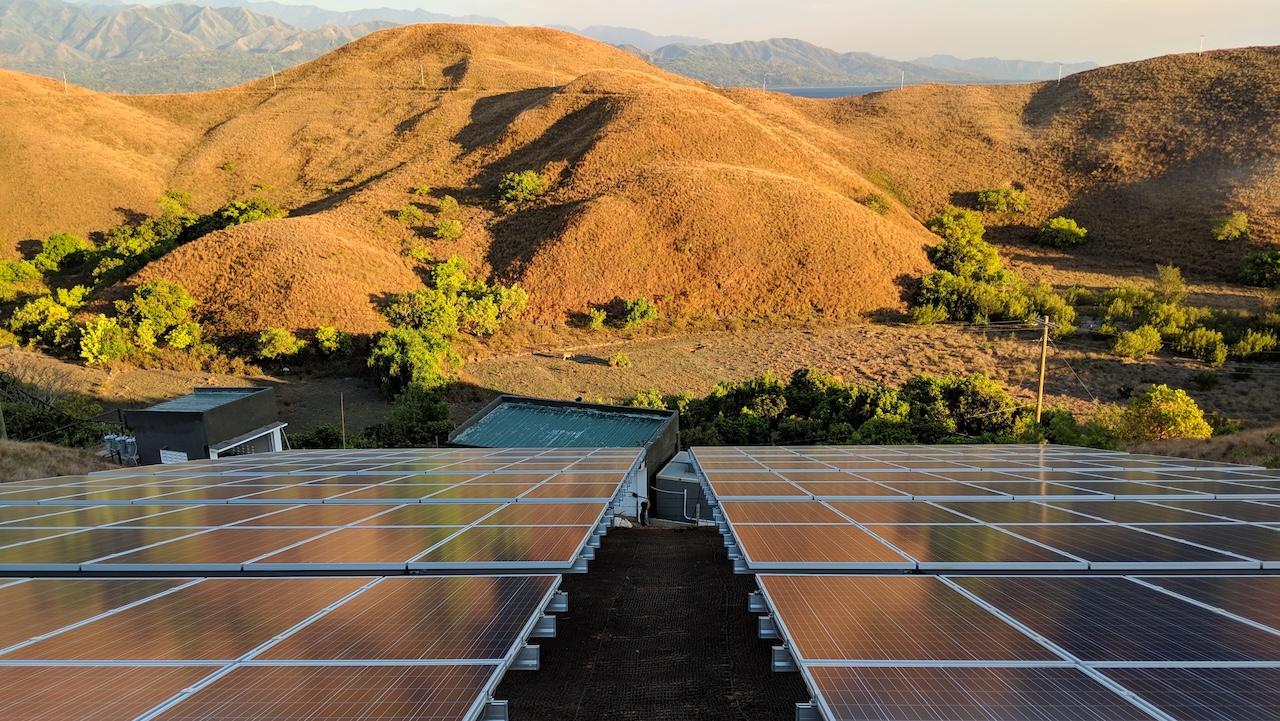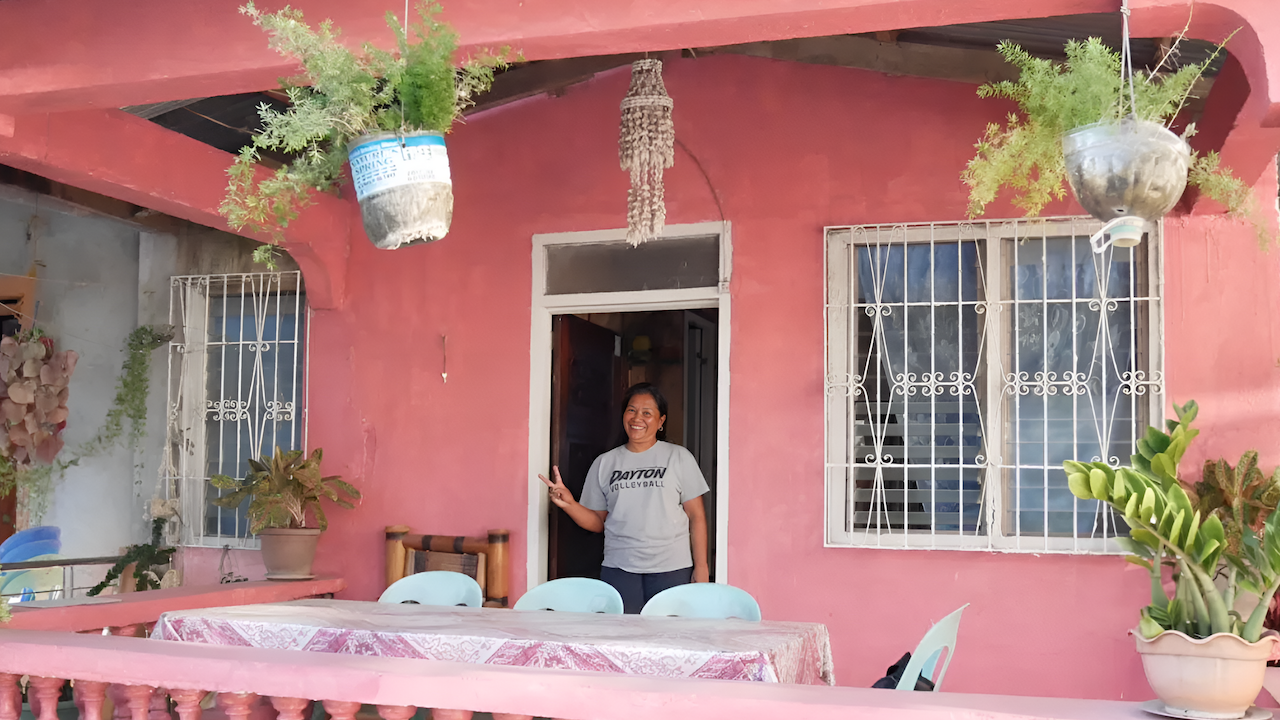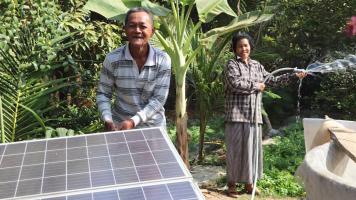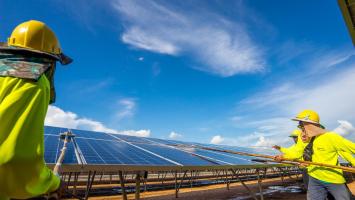
The Malalison Island solar photovoltaic hybrid power plant consists of a 50-kilowatt photovoltaic system with 273-kilowatt-hour lithium‑ion batteries and a 54-kilowatt diesel back‑up generator designed to produce 200 kilowatts power, around the clock. Photo credit: Courtesy of the Energy Sector Office, ADB.
For the people living on Malalison Island in the Philippines, getting 24/7 electricity supply has been life-changing.
Life has not been the same for Haida Doroteo, 53, since the small island she calls home in Western Visayas in the Philippines started to get electricity around the clock from a hybrid solar power plant commissioned 5 years ago. Before the plant became operational, power availability was limited to just 4 hours a day, with a diesel generator providing the supply.
While many take 24/7 electricity access for granted, it was life-changing for Doroteo and the other residents of Malalison, a 55-hectare island in the municipality of Culasi, Antique Province.
Game changer
Daily life is now easier and more comfortable on the island as better energy access has lifted living standards and livelihoods.
With electricity always available, households can run appliances for longer periods, reducing household chores. Conveniences such as electric fans, air conditioners, refrigerators, mobile phones, among others, can now be used for extended periods, making daily life easier.
Improved electricity access allowed residents to start businesses. The acquisition of refrigeration appliances enabled women and housewives to engage in supplemental income-generating activities, such as the selling of ice, cold drinks, and refreshments.
Improved power access enabled homestay businesses on the island to extend their operating hours from 8 hours to 24 hours daily and offer air-conditioned rooms to visitors. As a result, families who opened homestay businesses were able to earn income that was previously unavailable when electricity was limited to only 4 hours daily.
Children were also able to study at night and teachers gained access to educational tools, such as computers, internet, etc., which greatly enhanced their teaching methods and strategies. This largely improved the school’s educational services, as teachers became effective in addressing the diverse needs of learners.

A case for mini-grids
Energy access has improved since the plant’s commissioning. As of 2023, about 188 consumers were connected to the mini-grid, up from 148 in 2015, when the island was first evaluated as a potential project site.
The power plant features a 50-kilowatt (kW) solar photovoltaic (PV) system with 273-kilowatt per hour lithium-ion battery and a 54-kW diesel back-up generator. The system was designed to produce 200 kW power 24/7, with the generator kicking in when the batteries run out.
The project is a private sector joint venture between the Antique Electric Cooperative (ANTECO), the electric distribution franchise holder, and One Renewable Energy Enterprise, Inc. (OREEi), which operates the power plant and manages the prepaid metering system implemented within the project. The Asian Development Bank (ADB), through the Energy Sector Office, Sectors Group, provided technical assistance in piloting the project. Support was also extended by the National Electrification Administration (NEA).
The total cost of the project was ₱28.1 million ($521,027.82). ANTECO’s equity contribution amounted to ₱7.1 million, while OREEi provided ₱10.23 million. ADB provided a ₱10.8-million grant, fully funding the metering system and part of the storage system.
When the project was first announced in 2019, ADB stated that the system in Malalison represented an inaugural implementation of an off-grid operations by an electric cooperative in the country.
The project demonstrated that hybridizing diesel-based power supply generation in small islands in the Philippines is a viable solution for off-grid electrification. With the Philippines having 7,641 islands, numerous smaller islands are beyond the reach of electricity grids.
Multiple benefits
The project yielded multiple benefits.
An ADB report evaluating the project’s socioeconomic impact based on household surveys revealed that 93% of respondents expressed appreciation for the project.
Thirty percent of respondents reported an increase in their income soon after the project commenced operations. The increase in income was attributed to the growth in tourist visits to the island as well as boosted sales driven by extended hours of operations and wider variety of product offerings.
Consumers also enjoyed lower energy prices as a result of the system. The electric cooperative was able to reduce the price levied to consumers by ₱20/kWh to an average of ₱10.35 per kWh in 2019 from ₱30.15 prior to the project. ANTECO achieved this by blending generation costs from the solar plant into the generation costs of its whole franchise area in Antique. Consequently, residents were able to enjoy electricity service at the same price as consumers on the mainland.
The prepaid metering system introduced with the project has proven advantageous for low-income households, especially daily wage earners and those without fixed incomes. The ability to purchase electricity loads in smaller increments or based on the customer’s financial capability has improved access. With the system, households are relieved of the burden of being disconnected and incurring reconnection charges. Prepaid metering has also raised consumer awareness about energy efficiency by promoting real-time monitoring of consumption, which incentivizes consumers to be more mindful of their electricity usage.
The project also had positive environmental impacts. Seventy-seven percent of the power generated comes from solar energy, reducing reliance on fossil fuel. Over the course of the plant’s operation, it generated 317,899 kWh of solar power, mitigating about 381.48 tons of carbon dioxide equivalent greenhouse gas emissions.
Scaling the solution
ADB indicated that the benefits derived from the pilot project demonstrate the potential for scaling a hybrid solar power system to other off-grid communities across the archipelago, thereby improving energy equity and increasing resilience. While the country’s electrification status reached 91.1% as of June 2023, around 6.13 million households remain unserved, of which 1.29 million are in off-grid areas.
The Malalison project affirms that there is private sector interest in off-grid electrification. Given the opportunity, the private sector has the potential to share and contribute valuable knowledge and management skills to improve and ensure viability of projects. Local governments play a crucial role in facilitating the implementation of these projects.
The project highlights the value of partnerships and collaboration in the introduction of innovative and strategic solutions to achieve shared development goals.
The ADB report recommends that projects similar to the Malalison solar hybrid project should be replicated in other parts of the country. This strategy will help achieve the government’s goal of 35% renewable energy in the energy mix by 2030 and 50% by 2040.
The publication of the Socioeconomic Assessment Report of the Malalison Island Solar Photovoltaic Hybrid Project was funded by the Asian Clean Energy Fund and Clean Energy Fund under the Clean Energy Financing Partnership Facility.


